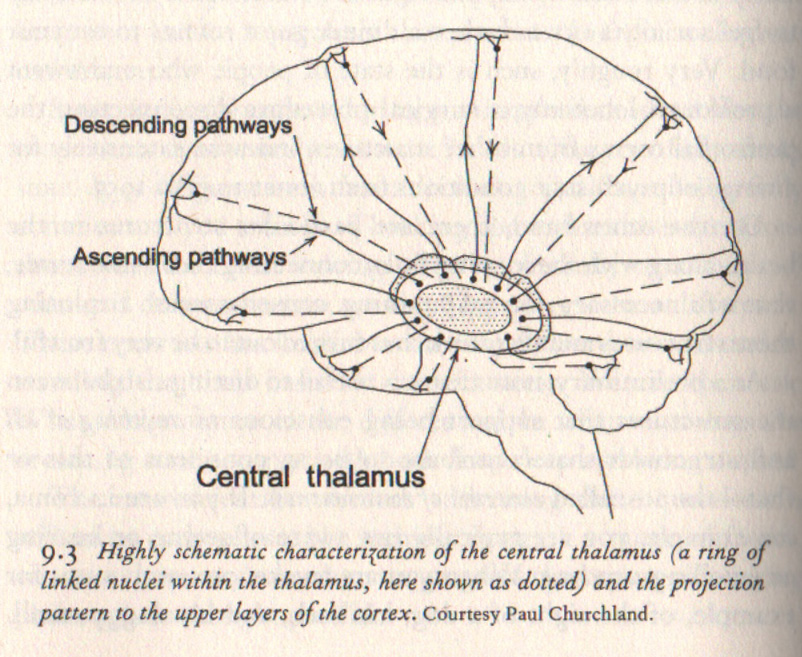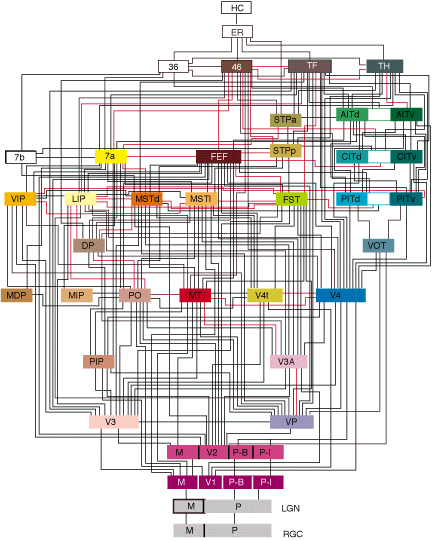17. Self - just throwing this in
self
Richard Schwartz's Parts Therapy has the Self as an organizing principle. The self is totally calm and has ample untapped energy. The official name of Parts Therapy is IFS, Internal Family Systems, which makes sense from how the model got articulated.
Mindfulness Training and the default mode network.
I just learned about the Default Mode Network in August 2014, but, I have been intensely interested in consciousness for 10 years, and it seems clearer and clearer that every percept (sense datum) and thought is a nontrivial network connecting several or dozens of brain regions: https://www.jch.com/jch/notes/Consciousness.html
I went to the Resting State and Brain Networks conference as a perk (for fun), altho I did do some brain visualization about 10 years ago, I do not work with any neuro applications now. As a way to reprocess my notes, I put them on the web: https://www.jch.com/jch/notes/RestingState2014/
I am about 95% sure Helen Mayberg was the one who said this: (http://www.psychiatry.emory.edu/faculty/mayberg_helen.html)
" Mindfulness Training increases connectivity within the DMN "
So, what exactly does that mean? I'm not sure anyone really knows, yet. I only read the abstracts of the 3 papers here. There are more that seem very close in topic. It takes me hours to read these, since I need to look up so much stuff and ruminate on it. Here is the order I would red them in:
1) Increased default mode network connectivity associated with meditation.
http://www.ncbi.nlm.nih.gov/m/pubmed/21034792/
2) Impact of meditation training on the default mode network during a restful state.
http://www.ncbi.nlm.nih.gov/m/pubmed/22446298/
3) Paper: Meditation experience is associated with differences in default mode network activity and connectivity
- http://m.pnas.org/content/108/50/20254.full
- coverage: http://m.psychologytoday.com/blog/look-around-and-look-within/201201/mind-wandering-and-mindfulness
This is blog is really fun, but, this guy is taking some facts and running with it. Nobody else refers to the DMN as the "inattention" network, and his history is missing at least one important development in 1995. http://www.mindfulnessmd.com/2014/07/08/neuroscience-of-mindfulness-default-mode-network-meditation-mindfulness/
WikiPedia - http://en.m.wikipedia.org/wiki/Default_mode_network
Helen Mayberg also talked about Deep Brain Stimulation for severely depressed patients, where an electrode implanted near the thalamus fires every 7 ms, and the depression lifts immediately. This struck me because "microstates" last about 10 milliseconds. They are the "atoms of thought" - the minimal time slice for a dominant coalition to hold the cortical thalamic complex.
Conscious percepts are unitary and internally consistent at any given moment. The brain has many anatomical hubs, but This suggests that a brain-based GW capacity cannot be limited to only one anatomical hub. Rather, it should be sought in a dynamic and coherent binding capacity – a functional hub – for neural signaling over multiple networks. A number of findings are consistent with the theory.
At the end of the book. It is hard to say which of the many assertions are actually the numbered assumptions, but who am I to quibble?
1A) Forward Projections are strong to the front of the cortex. Feedback modulates feed forward.
1)Nonconscious Homonunculus: We are not conscious of the highest levels of cognition.
2) Zombie Agents handle much of our actions. Anything we do unconsciously, things we train for. Things handled by the Dorsal pathways & "gist perception"
Consciousness handles the exceptions (See Hawkins) and it presents an executive summary to the planning stages.
3) Conscious precepts are the results of a single winning coalition of neurons with at least some prefrontal parts of the network
4) Explicit representation of some stimulus is a set of neurons. Lose those and you no longer perceive that stimulus.
The cortex is a large set of nodes. A "column" is the smallest useful node.
5) Net wave from V1 up hierarchy (See Van Essen) to the prefrontal cortex. Then it travels back down the hierarchy as feedback. Visual Consciousness probably starts at teh upper stages of the ventral pathway in the Inferior Temporal cortex. (Ventral congizes, Dorsal does)
6) Driving and modulatory loops: To understand coalitions we must understand the neural connections. Excitatory cells send driving or modulatory charges. From the back of the cortex to the front are mostly driving charges. Loops of driving charges are bad.
7) Perceptual awareness may be a series of snapshots with motion "painted on". Each snap lasts 20-200 milliseconds (ms) (it takes 250 ms to "see" something)
8A) Attention: There are two types of attention: a) bottom up saliency driven and b) top down and volitionally controlled. Bottom up would be a sensory net wave that breaks thru. For example, a ball flying at you.
There is also "gist perception" which allows us to go thru the world on auto pilot. As long as nothing salient happens, we are not really conscious of a lot of our daily activities. Like when we drive home and remember no details of the drive.
8B) Binding: Various attributes of a single object are identified by essential nodes. How these are tied together is the "binding problem". There are three types of binding: 1) lower level, V1 binds location and orientation; 2) trained binding, face, voice and hair mean Grandma; 3) novelty binding - requires top down attention
9) synchrony of action potentials discharge in the 30-60Hz range may help in forming nascent coalitions. Firing in the 4-12 Hz band may be part of snapshot processing.
10) Winning coalitions recruit from the cortex, thalamus, basal ganglia and other networks. In addition to the neurons that are explicitly part of the NCC is the penumbra which includes past associations, background and future plans. The penumbra provides meaning or the potential for meaning which might only happen if the NCC expands to those nodes.
Summary from Baars 2013 (paragraph numbers added)
1) A GW is a functional hub of signal binding and propagation in a population of loosely coupled signaling agents. Neurons and neuronal cell assemblies can be defined as such agents when they respond selectively to input.
2) Conscious experiences may reflect a GW function in the brain. The brain has many anatomical hubs, but conscious percepts are unitary and internally consistent at any given moment. This suggests that a brain-based GW capacity cannot be limited to only one anatomical hub. Rather, it should be sought in a dynamic and coherent binding capacity – a functional hub – for neural signaling over multiple networks. A number of findings are consistent with the theory.
3) In humans the C-T complex underlies reportable conscious percepts, concepts, FOK, visual images and executive functions. While subcortical areas are often sometimes proposed to specify conscious contents, the human evidence is slight and disputed. Because cortex and thalamus are interleaved so densely as to constitute a single functional system, we will refer here to the C-T system as a whole. C-T pathways permit constant reentrant signaling, so that multiple spatiotopic maps can sustain or inhibit each other. The daily states of the core are controlled by basal brain nuclei.
4) Global workspace theory follows the historic distinction between the “focus” of experience vs. the largely implicit background of experience. Extensive evidence shows that visual and auditory consciousness flows from the respective sensory cortices to frontoparietal regions. This directionality differentiates GW dynamics from information integration theory and dynamic core theory.
5) Cortico-thalamic core is a great mosaic of multi-layered two-dimensional neuronal arrays. Each array of cell bodies and neurites projects to others in topographically systematic ways. Since all C-T pathways are bidirectional, signaling is “adaptively resonant” (reentrant). In this complex, layered two-dimensional arrays are systematically mirrored between cortex and thalamus, region by region.
6) The C-T nexus appears to be the most parallel-interactive structure in the brain, allowing for efficient signal routing from any neuronal array to any other. This connectivity is different from other structures that do not directly enable conscious contents, like the cerebellum. The cerebellum is organized in modular clusters that can run independently of each other, in true parallel fashion. But in the C-T core any layered array of cortical or thalamic tissue can interact with any other, more like the world-wide web than a server farm.
7) Cortico-thalamic pathways run in all canonical directions and follow small-world organization, so that each array is efficiently linked to many others. The entire system acts as an oscillatory medium, with markedly different global regimes in conscious and unconscious states.
8) Global workspace dynamics interprets the traditional distinction between the “object” and “ground” of experiences as a directional flow between the moment-to-moment focus of conscious experience vs. the implicit background and sequelae of focal contents. The proposed directionality of broadcasting suggests a testable distinction with information integration theory and dynamic core theory.
9) For example, while sensory experiences are proposed to bind and broadcast from posterior cortex, “fringe conscious” FOK plausibly emerge from non-sensory cortices, and may therefore broadcast rostrocaudally.
10) Finally, dGW suggests the counter-intuitive idea that in intact humans, the MTL supports conscious episodes. The classic lesion case of HM seems to contradict that idea, but traditional psychophysical testing does not show episodic organization. We therefore suggest that the positive evidence from brain recording methods for conscious experience in MTL may outweigh lesion evidence against it, given the well-established tendency toward cortical reorganization after injury.






















